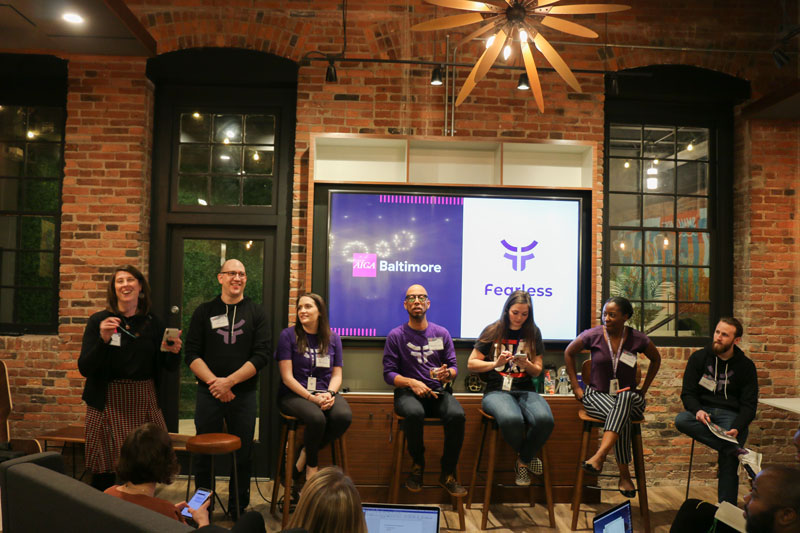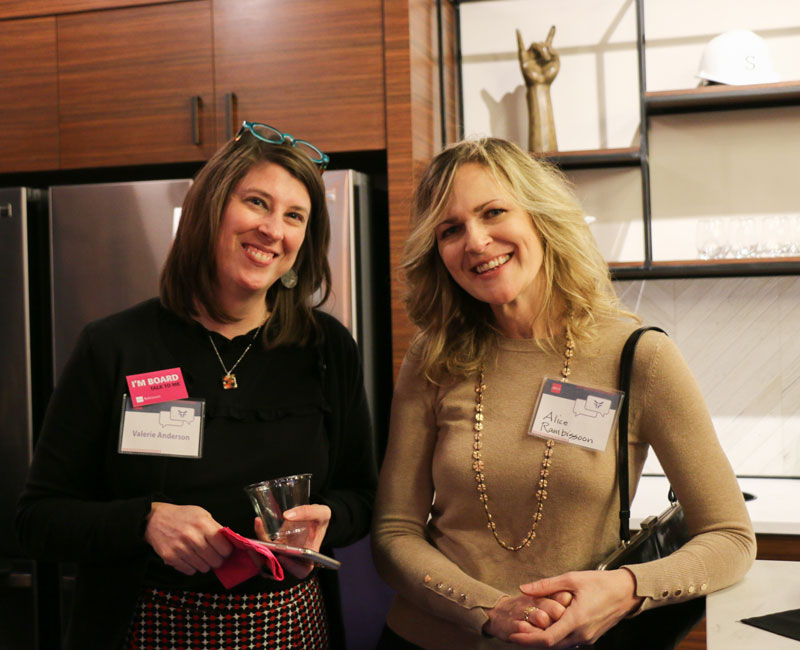The AIGA Baltimore community had the pleasure of sitting down with Fearless, a full-stack digital services firm, this January to discuss current trends and skills user experience (UX) and user interface (UI) designers need to know. And it’s not as scary as you might think.
Meet the Players
Held at Fearless headquarters inside of Spark Coworking Spaces in downtown Baltimore, the event was a panel-style Q&A. Panelists included:
Jordan Watts, Lead UX Designer, UX Coach
Antoine RJ Wright, Lead UX Designer, @ARJWright
Amanda Mancuso, UX Designer
Tyler Bolchoz, Product Designer
Rachel Petrucci, Product Designer
Daedriana Harvey, UX Designer

Photography Credits: Krystal Carpintieri
The Landscape
The UX/UI space is constantly changing as technology advances at lightning speed. Designing for non-traditional interfaces (smartwatch, eyewear, ring, etc.), voice user interface (VUI), and augmented reality (AR) and virtual reality (VR) will be the shiny new skills UX and UI designers will be homing in on. However, as technology changes, it’s often challenging for designers to gain experience in the latest and greatest and break into the UX/UI field.
What we learned from speaking with Fearless is that yes, UX and UI designers should have experience in design, code, content, research, and strategy (at varying levels of each, and that’s okay!); but that it’s equally important for UX and UI designers to possess super-sleuth soft skills and a fierce desire to learn. That’s far less daunting.

Photography Credits: Krystal Carpintieri
Skill 1: Collaborate Well with Others
In the past, there’s been clear segregation between designers and programmers. Designers would figure out what the “thing” (website, landing page, app, etc.) would look like, then hand it over to the programmers to code and be done with it. And as you can imagine, there’s bound to be some friction with this process.
“It’s not really a design hand-off, it’s a design implementation.”
—Rachel Petrucci, Product Designer
These days, the concept of a “hand-off” has vanished. At Fearless, as with many other agencies, designers and programmers work together in a very integrative process. Designers and programmers come together for scrum reviews and standup meetings, and developers are invited to design reviews and product testing. As Rachel put it, “it’s not really a design hand-off, it’s a design implementation.”
That means whether you’re a designer or a programmer or a magical unicorn who does both, you must possess strong communication skills and a willingness to collaborate. Designing in a technologically advanced space means you’ll need to rely on others to create a successful product. Designing at this scale does not happen in a vacuum. As Tyler said, “you’re doing the product a disservice if you just hand it over, but if you’re collaborating everyone is engaged.”

Photography Credits: Krystal Carpintieri
Skill 2: Learn How to Build Empathy
We asked our Fearless panel what steps they take when asked to build a website from scratch. Across the board, step one was research. Before design is even a consideration, learn everything you can about the needs of your client. Do they need a website, or would they be better served by an app? The research phase also includes market research, identifying pain points and opportunities, and sitting with the users—it can take weeks.
“Your perspective is not the default”
—Jordan Watts, Lead UX Designer, UX Coach
But the critical part of researching is gaining the ability to build empathy for your users. Putting yourself in the shoes of the user is the most effective way to create successful UX and UI design. As we discussed inclusive design, Antoine suggested starting a design with the least-sited person in mind, then build up. Can this person use the product on a watch, how about on a mobile phone, tablet, non-touch computer, touch computer, etc.
Jordan summed it up best by saying, “your perspective is not the default.” Having empathy for users and being able to tap into how others will use the product (via user testing, research, etc.) will help you reach every user and create a better product.

Photography Credits: Krystal Carpintieri
Skill 3: Be Hungry to Learn
As technology continues to evolve the only way designers and programmers can stay relevant is to stay hungry…to learn. Without a constant desire to learn, the skillsets of those in the tech industry will inevitably turn stale.
When we asked panelists what the top characteristic trait was that they look for in a new hire, Rachel and Amanda said they would hire someone who is curious and actively seeks out opportunities to learn and develop new skills. Antoine and Jordan discussed the merits of cross-functionality—and yes, there is value in knowing how to design and code—but it is equally important to understand your area of expertise.
So, if you’re looking to impress your current managers or are looking to break into the UX and UI space, take the initiative to develop your skillset. Attend hands-on boot camps and workshops (rather than lectures) to develop your skills, portfolio projects, and gain experience. As Amanda put it, in an interview she would rather hear about what you learned from failed experiences, rather than hear a candidate prattle on about what they think she wants to hear.

AIGA Baltimore President, Valerie Anderson with the Interior Designer of the Spark Co-Working Space, Alice Rambissoon. Photography Credits: Krystal Carpintieri
What Did We Learn?
It’s no big surprise that the UX and UI fields are growing, and the demand to create beautiful, interactive products for numerous interfaces will continue to grow as well. Being on the cutting-edge of these technologies means possessing the technical skills, yes, but equally as important is being able to demonstrate how UX and UI can add value. That means learning how to be a strong communicator (and listener!), being empathetic toward clients and teammates, and being a dedicated, lifelong learner.
If you’re interested in learning more about Fearless, head over to fearless.tech; and if you want to join the Fearless team, check out fearless.tech/careers.
Follow Fearless on Twitter, Instagram, LinkedIn, and Facebook at @fearlessbmore. And follow AIGA Baltimore—@aigabaltimore—on all your favorite channels so you never miss great events like this one!
Share your thoughts below on what skills should be on the minds of UX and UI designers as we move into 2020!